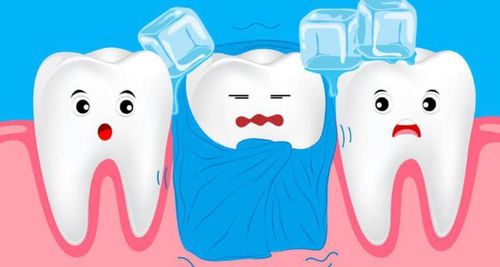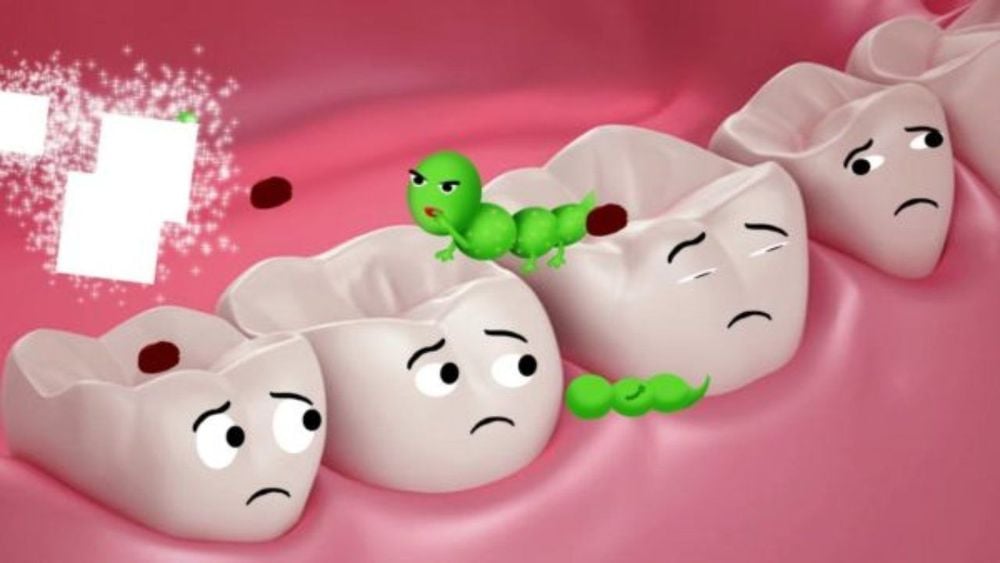This is an automatically translated article.
Pulp necrosis is a condition in which the pulp inside your tooth dies. Necrotic pulp is the final stage of chronic pulpitis. It can lead to other problems with your teeth if not treated promptly.1. How does a necrotic tooth pulp present?
The innermost part of each tooth has connective tissue called pulp. The pulp extends from the root to the crown of the tooth. The pulp itself is an intricate design of blood vessels and nerves that help keep your teeth healthy from the inside. The pulp is divided into two parts: the canal located at the bottom of the tooth and the pulp chamber located in the crown of the tooth.
When you have dental diseases, the pulp can be affected and eventually die. This can lead to other oral health problems if not treated promptly.
Most of the symptoms indicate that your tooth and the inner pulp of your tooth had problems before the gangrene . This is because once necrosis begins, the nerves can stop sending signals to alert you to any pain or discomfort, because the pulp has died.
In the early stages of pulp problems, your teeth are especially sensitive to cold foods or drinks. Sweets can also make teeth worse. Your teeth will feel uncomfortable for about one to two seconds each time they are exposed to cold.

Tủy răng bị hoại tử nhạy cảm với đồ lạnh
Once the pulp is necrotic, you don't feel cold at all. However, you may feel increased pressure in the affected tooth when you eat or grind. This pressure also lasts several minutes at a time. If you have no feeling in that tooth, this could be a sign of gangrene.
A tooth can become necrotic from untreated decay, trauma, or large fillings. When the pulp is necrotic, it means you have irreversible pulpitis and you will have to destroy the pulp or have the tooth extracted.
2. Check the pulp of the tooth for necrosis
Before testing for pulp necrosis, your dentist will first examine your teeth, gums, and other surrounding tissues. Sometimes, you don't know this condition, it can only be discovered after undergoing a dental exam. Dental X-rays are also helpful in identifying areas of caries or abscesses that may contain pulp necrosis.
If pulpitis or necrotic pulp is suspected, your doctor may use a tool called a pulp tester. This tool creates small shocks to the teeth. If you can feel the shock, the pulp is alive. If nothing is felt, the pulp may be necrotic.
3. Causes of necrotic tooth pulp
Pulp necrosis usually begins with caries. Tooth decay begins with a buildup of plaque, which leads to holes in the enamel of your teeth. When detected early, cavities will be filled by the dentist and should not cause any other problems. However, if a cavity continues to decay your enamel, the effects will eventually move into the pulp. Eventually, the pulp can become necrotic.
Another cause of pulp necrosis is chronic pulpitis. This involves long-term inflammation (swelling) of the pulp due to long-term decay, trauma, and multiple major restorations. Pulpitis in the necrotic stage is considered irreversible.

Tủy răng bị hoại từ bắt nguồn từ sâu răng
4. Treatment options for necrotic pulp
Treatment options for pulp necrosis can vary depending on the stage and severity of the condition. Your dentist may recommend one or more of the following treatments:
Fillings: Your dentist can fill existing cavities to prevent further decay. Also, old or unsatisfactory fillings can be removed and replaced. This helps protect not only your teeth, but also the pulp inside your teeth. Root canal: In this procedure, the dentist removes dead tissue throughout the pulp chamber and root to clear out the infection. A gentle solution is used to clean the root canal thoroughly. Your dentist will then apply a special filling called gutta-percha. Sometimes, you need more than one root canal before your condition improves and the root canal is complete. Root canal removal: This is a treatment method applied in cases of pulp necrosis due to irreversible pulpitis. During this procedure, the dentist will make a small hole in the tooth and remove the dead pulp by hand. Tooth replacement: Depending on the severity of pulp necrosis, the dentist may remove the entire tooth with pulp necrosis. You can choose from a number of tooth replacement options depending on your budget and preferences.
5. Complications and conditions associated with pulp necrosis
It is not possible to restore a necrotic pulp without a root canal and/or extraction of the affected tooth. Complications can develop over time if damaged teeth are left untreated. However, the treatment itself can also lead to complications. With pulp necrosis and its treatment, you are at risk for the following complications:
Infection . Fever. Jaw swelling.

Tủy răng bị hoại tử sẽ gây ra sưng hàm
Cellulitis. Abscesses include abscesses in the brain. Sinusitis. Periodontitis. Bone loss. When it comes to oral health, any form of inflammation or decay in the teeth and surrounding tissues can create a domino effect that leads to serious tooth damage. Therefore, pulp necrosis is a phenomenon after your teeth already have other problems. The dead pulp cannot be restored, pulpectomy and extraction are your two treatment options when the pulp is necrotic. Overall, the best way to prevent pulp necrosis is with care. your teeth and gums. To examine and treat dental problems, you can go to the Department of Odonto-Stomatology - Vinmec International General Hospital. Vinmec is a high-quality medical facility in Vietnam with a team of highly qualified medical professionals, well-trained, domestic and foreign, and experienced. Current medical equipment system Modern, advanced, possessing many of the best machines in the world to help detect many difficult and dangerous diseases in a short time, supporting the diagnosis and treatment of doctors most effectively. Hospital space designed according to 5-star hotel standards will bring patients comfort, friendliness and peace of mind.
Please dial HOTLINE for more information or register for an appointment HERE. Download MyVinmec app to make appointments faster and to manage your bookings easily.
Reference article: healthline.com












